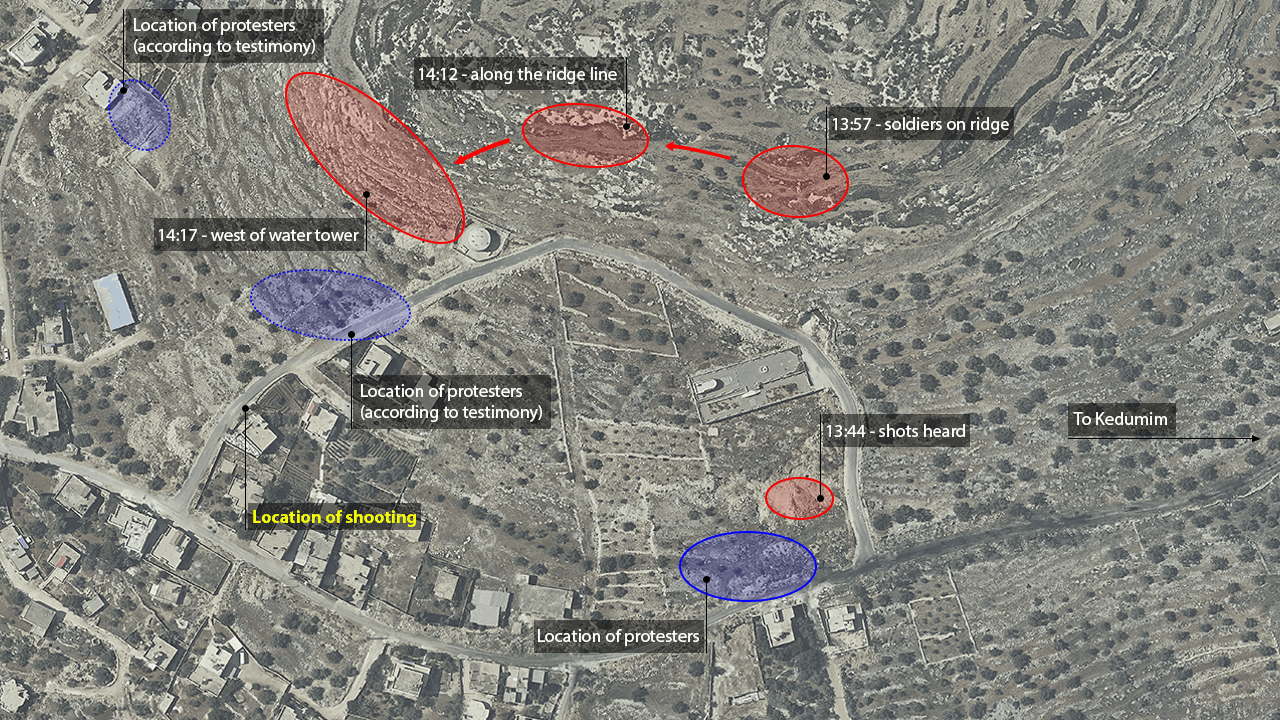
On 12 July 2019, nine-year-old Abd el-Rahman Yasir Shatawi was shot in the head by an Israeli soldier in the Palestinian town of Kafr Qaddum, in the occupied West Bank. He remains hospitalised, and his long-term condition is unclear.
Abd el-Rahman was shot while standing at the entrance of his friend’s house. Just 30 minutes earlier, he had been filmed buying sweets in a nearby grocery store.
A CT scan subsequently revealed around 100 fragments lodged throughout Abd el-Rahman’s brain.
As part of the Israeli army’s open-fire policy in the Occupied Palestinian Territories, Israeli soldiers regularly use live ammunition against Palestinians, even when those soldiers are not directly or immediately in danger.
According to the NGO B’Tselem, this policy is ‘a crucial element in Israel’s ability to maintain violent control over millions of Palestinians’, and is evidence of its ‘profound disregard’ for Palestinian lives. In Kafr Qaddum, the policy appears to have led to the horrific and lasting injuries suffered by Abd el-Rahman.
On the day of the incident, an Israeli army spokesperson denied that live ammunition had been used. Unnamed military officials have since repeated this claim.
At the request of the organisation International Solidarity Movement (ISM), Forensic Architecture used video material recorded that day to piece together the sequence of events that led to the shooting.
Contrary to the repeated claims of Israeli officials, the available medical and image evidence, as well as witness testimony, strongly suggests that Abd el-Rahman’s injuries were caused by live ammunition.
Background
Kafr Qaddum is in the northern occupied West Bank, seven miles west of the city of Nablus. The town is surrounded by a block of illegal Israeli colonies, including Kedumim, one mile to the east.
Over four decades, the growth of these colonies has steadily encroached onto land belonging to the town.
Since 2011, Palestinian residents of Kafr Qaddum have held weekly protests against the Israeli occupation, against land confiscations by nearby colonies, and against the closure of the main road between the town and the nearby city of Nablus. That road was blocked by Israeli forces to accommodate the expansion of Kedumim, doubling the duration of travel from Kafr Qaddum to the nearest major economic centre.
During these protests, residents and activists are regularly confronted with various ‘crowd control methods’ used by the Israeli army, including rubber-coated metal bullets, stun grenades, and tear gas.
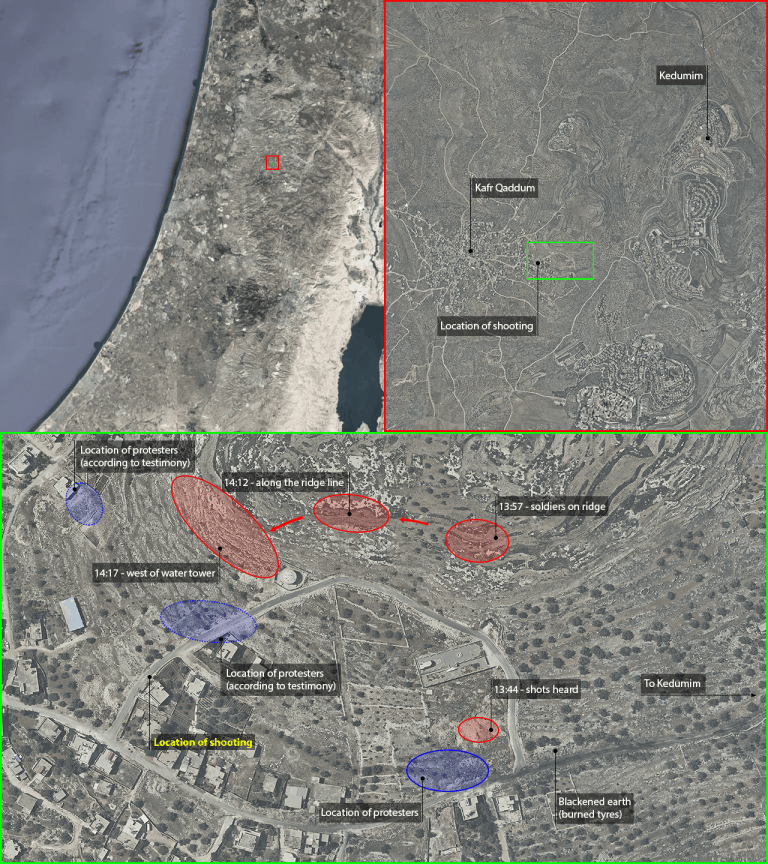
12 July protest
At around 13:00, protesters began to march east, from the centre of the village towards the roadblock. As they reached the eastern edge of the village, they were violently confronted by Israeli occupation forces on the hillside to the north.
At first, the soldiers use rubber-coated metal bullets and stun grenades. But, according to witnesses, around 13:30 they begin to use live ammunition. In the video below, from 13:44, live gunfire is audible.
We can geolocate the protesters using features seen at the end of the clip. Kedumim is visible in the distance.
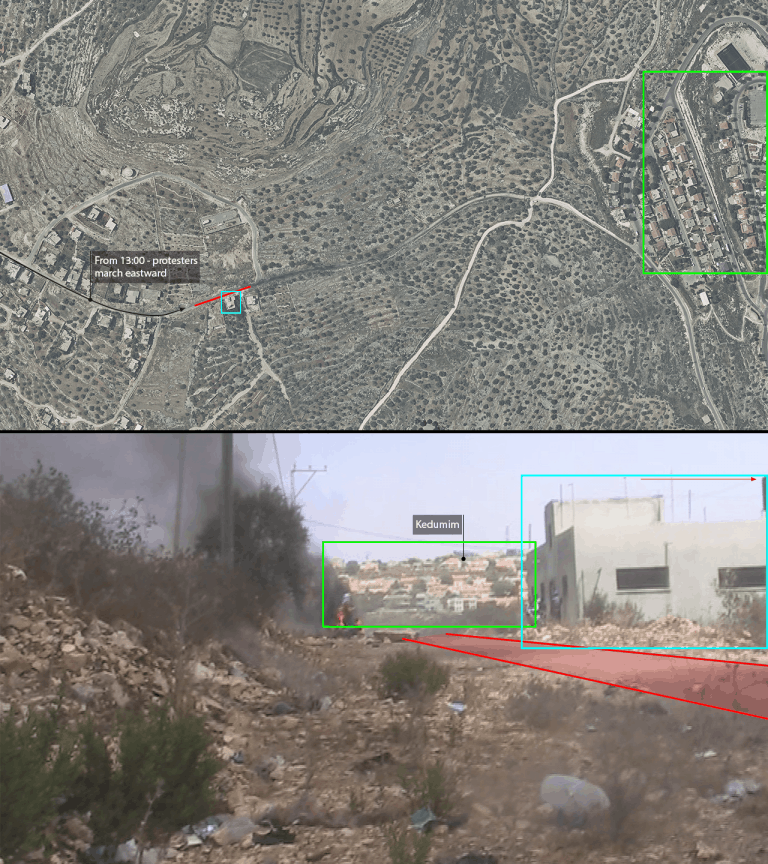
Israeli military officials have denied that live ammunition was used that day. However, in this clip, likely recorded sometime between 13:44 and 14:00, an Israeli soldier can clearly be seen firing live rounds over the head of a Palestinian protester.
The UN Office of the High Commissioner for Human Rights (OCHCR) later said that there was no ‘apparent reason to justify the move to lethal force.’
Compare the behaviour of the soldier above to that seen in the video to the right, which shows what the process of firing and reloading rubber-coated metal bullets looks like.
Israeli soldiers can be seen loading a round into the end of the rifle’s barrel before each shot, through an attachment designed specifically for rubber-coated rounds.
This sequence of actions is clearly not performed by the soldiers filmed in east Kafr Qaddum on 12 July, in the hours before Abd el-Rahman was shot.

Damaged water tank
Directly behind some of the protesters, and therefore in the soldiers’ line of fire, is a water tank. A video captured on the day of the incident shows water pouring from holes in the tank. And the photo below, taken the following day at Rafidia Hospital in Nablus, shows 5.56mm bullets reportedly collected from inside the water tank.
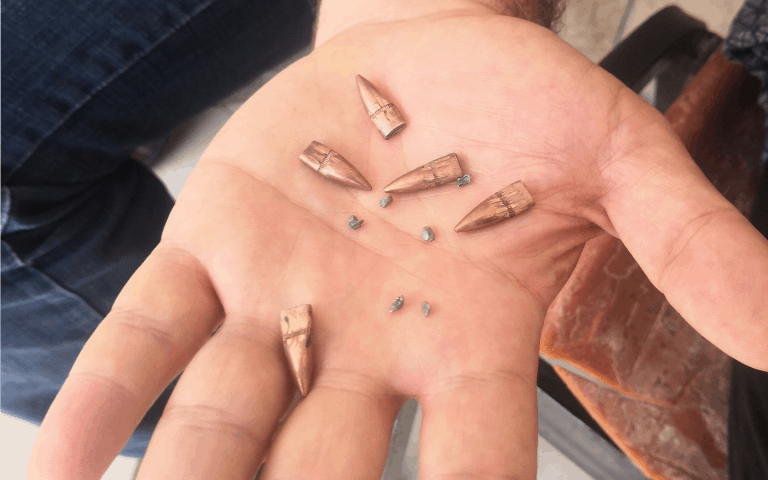
A photograph taken a week later, on 19 July, shows dark patches on the water tank. These are possibly patches of tar, used to seal the holes. Taken together, this evidence suggests that Israeli soldiers did use live ammunition in Kafr Qaddum on 12 July.
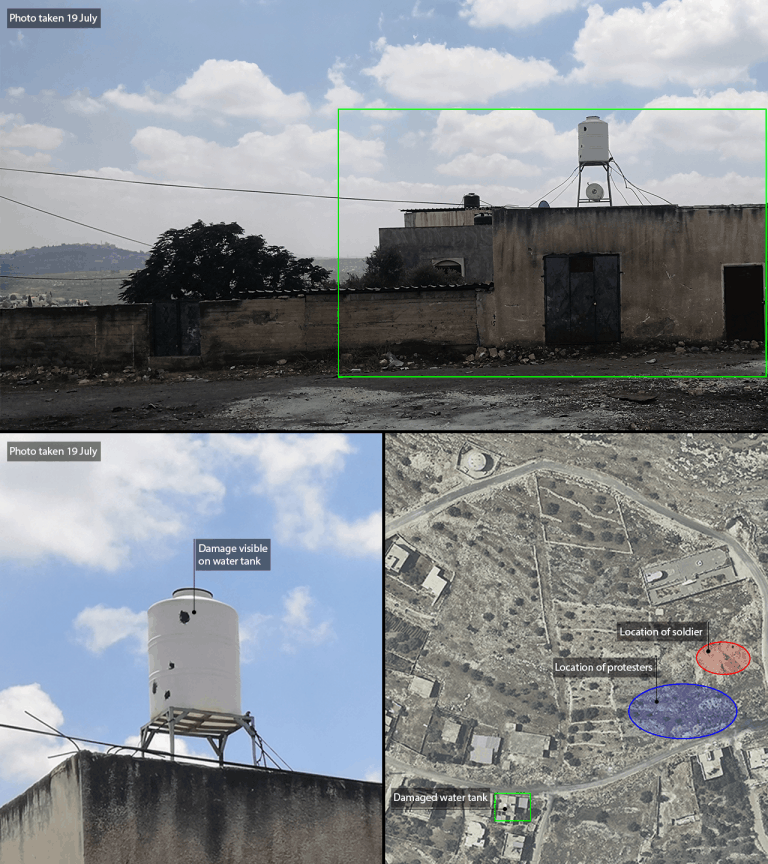
Injury to Abd el-Rahman
Soon after the first live rounds were fired, a second group of soldiers moved west along the hillside, north of the road where protesters were gathered.
In the video below, from 13:57, soldiers can be seen on the ridge line above the east end of the village.
And in this footage, from 14:12, another protester is confronted by two soldiers on the ridge line.
By now, this second group of soldiers are further west, on the hillside above the road on which Abd el-Rahman was shot and injured.
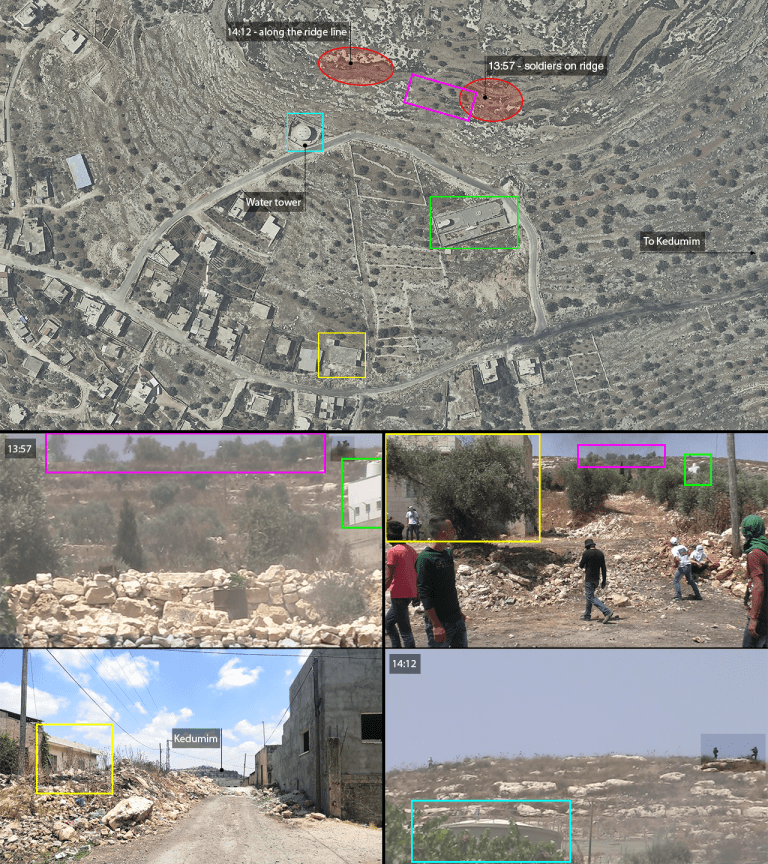
In the video below, from 14:17, minutes before Abd el-Rahman was shot, Israeli soldiers are still visible on the ridge on the hill.
According to witnesses, the soldiers moved downhill, to an area west of the water tower, while protesters threw rocks from the road that leads down toward where Abd el-Rahman was standing, in front of his friend’s house. In the video from 14:17, one soldier is already visible in that area.

Reports suggest that Abd el-Rahman was shot at approximately 14:20; a video from 14:25 shows the boy being carried into an ambulance.
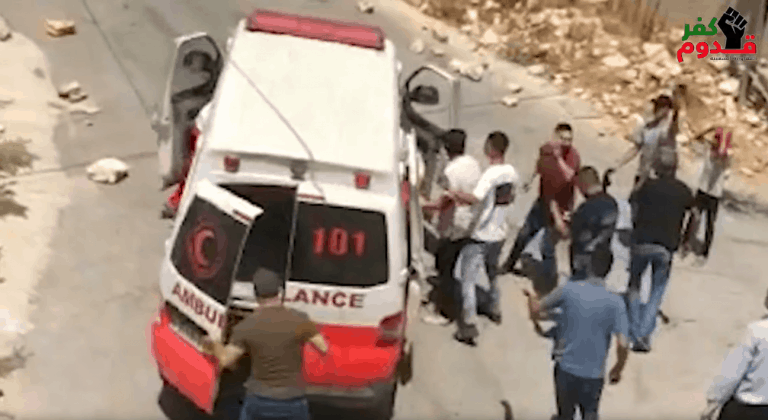
Photographs taken after the fact show 5.56mm ammunition casings on the hillside above the location of the shooting.
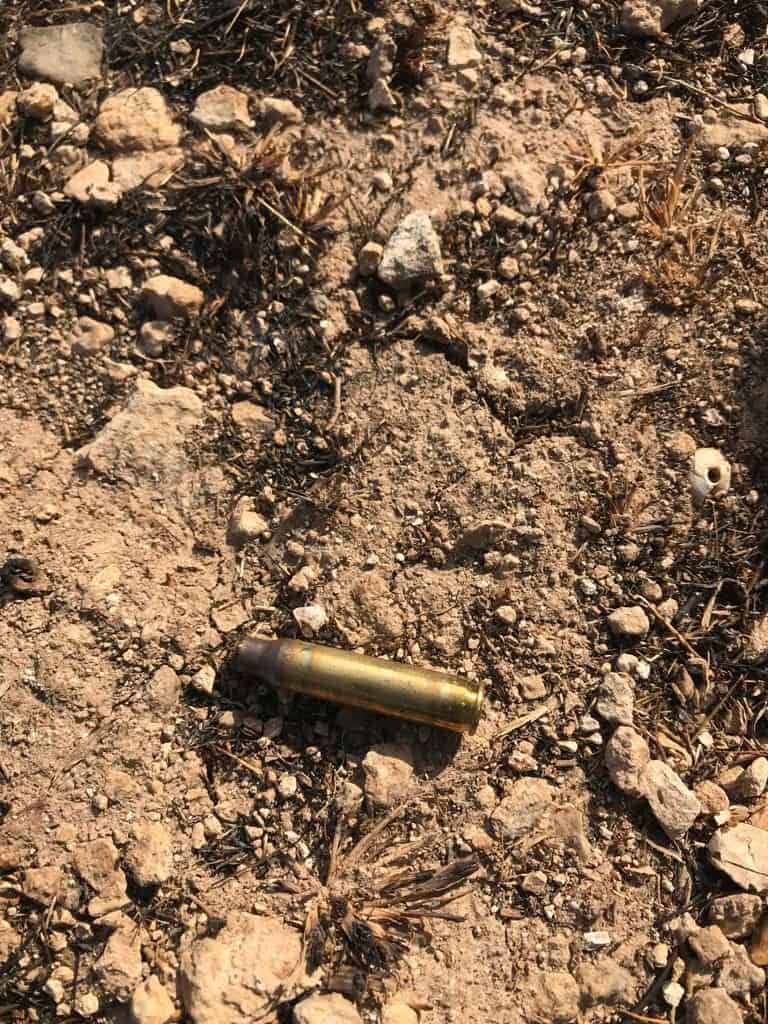
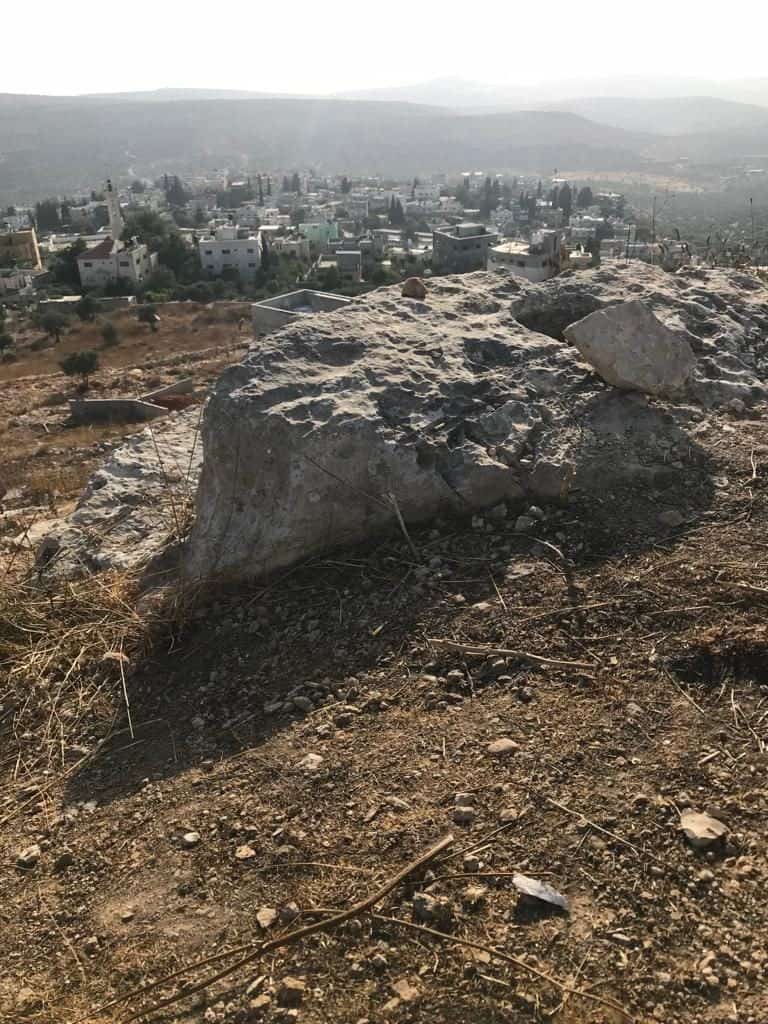
Injured by live ammunition
The Israeli army has claimed that Abd el-Rahman was more likely hit by a rubber-coated metal bullet than by live ammunition. As recently as 23 August, Israeli military officials insisted that Abd el-Rahman was not hit by live fire.
But forensics experts told us that this is extremely unlikely. ‘In our professional opinion,’ they said, ‘this injury is not consistent with a direct impact of an RCMB [rubber-coated metal bullet] projectile.’
The experts, who have asked to remain anonymous, claim that the fragmentation visible in CT scans of Abd el-Rahman’s head suggests that his injuries were caused by 5.56mm live ammunition: ‘The level of fragmentation is consistent with fragmentation seen in 5.56 mm rounds. It is inconsistent with the level of fragmentation one would expect to see with a steel-core rubber bullet.’
Evidence suggests that the shooting occurred at a range of 100–120m; almost twice the effective range of rubber-coated bullets, according to B’Tselem (p23).
The OCHCR has condemned the shooting by Israeli forces, stressing that children ‘must not be put at risk of violence’—a risk that is heightened when lethal force is used by the army in residential areas, and without apparent justification. In the last three months alone, the organisation reports, over 100 Palestinian children have been injured by live ammunition fired by Israeli soldiers.
Abd el-Rahman is the latest victim of the Israeli army’s practice of using live ammunition to disperse protests against the occupation.
Satellite imagery throughout courtesy of Peace Now, and Google Earth.